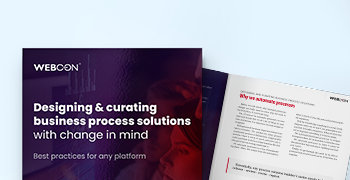This implementation of a digital complaints management solution, built with WEBCON BPS’ low-code platform, significantly improves the process of handling claims, complaints, and grievances. It unequivocally improves customer satisfaction in B2B and B2C industries, and noticeably reduces the stress associated with escalation handling.
Efficiently handling customer complaints is key fundament element of after-sales service, one that clearly affects a customer's satisfaction (and cooperation) with a supplier. Research shows that this process is also a source of significant stress for the employees who take part in it. Implementing a digital complaint handling solution is an excellent way to solve of these problems with a single effort.
Claims and complaints handling requires:
- Allowing issues to be submitted via a variety of channels,
- A clear definition of the procedure to be followed,
- Assigning responsibility to specific people for individual steps of the process,
- Regularly informing the client about the status of the complaint,
- Real-time reporting of execution times of individual tasks,
- Effective auditing of the quality of customer service,
- Easy identification of recurring problems (e.g., defective product groups or batches).
This process can, has been, and should be treated as a living, evolving solution; companies can constantly analyze the way it works, probe for bottlenecks, and look for ways to improve it. Examples of such enhancements include changing the scope of responsibility for individual users, automating previously-manual specific actions that add up to reduced time, reduced risk of errors – all without negatively affecting the quality of the process.
Digital Complaints Management Workflow Solution
Here’s how the most common complaint management workflow solution built with WEBCON BPS, behaves:
- Registration and classification of customer complaints is usually automated to the fullest possible technological extent, and can be done via a variety of channels (e.g., web pages, custom forms, email messages, mobile apps)
Therefore, a complaint request may be registered automatically as an HTML form filled in on a company’s public website; the page can call the WEBCON BPS webAPI to register the case and start the process. Alternatively that form can send an email to a designated mailbox.
If it’s an internal complaint, that can be done with built-in WEBCON BPS forms. This is just as often what is used by staff responding to complaints over telephone calls. It’s also possible to let users submit free-form emails, and have the resultant workflow pause for a moment to allow AI or a human operator to read and parse the content of the message into form fields.
An important element of the registration process is the categorization and classification of the complaint. It has an impact on analysis, on case worker selection, on response time, and a lot more.
Categorization can be carried out automatically based on business rules or decided by an operator. WEBCON BPS’ business rules engine can do things like fetching information about the customer's SLA level from an external database, the content management server’s contacts store, the company’s customer relationship management (CMS) software, or a dedicated contract management application (which itself might have been created with WEBCON BPS).
Categorization may both influence the path the workflow follows, the assignment of case workers, and a lot more.
Integrating the customer complaint management workflow with the companies ERP, POS, or other LOB service allows cases to automatically reconcile case details with referenced receipts, invoices or Stock Issue Confirmations.
Already at this stage, it is possible to display statistics on the frequency of lodging complaints and the distribution of complaint decisions for specific product group (or batch).
The use of cognitive services and other AI-based web services allows mechanisms like machine learning and artificial intelligence to do things like determine the emotional tone of the complaint, identify keywords, or do machine translation of its content.
The last element of the complaint registration is notifying account managers, based on the organization’s structure and market divisions, which can be maintained within the application or referenced from external data sources like the organization’s CRM.
- The method of handling the request queue depends on the size of the customer service department and the best practices developed by the company. In smaller departments, tickets are often assigned to specific individuals. In slightly larger organizations, tickets might be assigned to groups of users.
At any company size, the individual or group chosen need not be a manual decision. Business rules can look up data and reference which people or groups have expertise in the case’s subject matter areas, service level agreements, customer or industry segment, and so on.
In environment where the pool of available complaint handlers is larger, the solution already allows requests to be added to queues, and for case workers to work through the items in a queue either together or themselves. Then can proactively claim tasks to work on later. You can even govern how many cases each user can claim. Alternately, assignments can be made automatically on a random basis, on a matched subject matter expert basis, on a load management basis, on a calendar availability basis, or any combination of these and other factors.
Regardless of the chosen method of handling the request queue, the system remains aware of the expected time for resolving complaints, and the escalation mechanism may automatically override the standard method of assigning tasks and send additional notifications in the event of exceeding any deadline thresholds. This is particularly important in the case of industries where failure to resolve a complaint within the statutory deadline can trigger a number of financial and/or legal liability consequences.
- Handling the complaint is always carried out in accordance with the specificity of the product and company’s best practices. The complaint resolving stage is therefore either a single process step, handled entirely by a single employee, or as a series of tasks carried out either simultaneously or in a sequence (one after another).
Most often the workflows are configured in a way that, regardless of the standard processing path, it is possible to involve subject matter experts from other departments (or even other companies) to consult on (or provide additional information about) these cases. Extradepartmental people within the company could be product engineers, line managers, etc., and external company people could include component manufacturers, sub-suppliers, subcontractors, and so on.
Work on the complaint can be done via a web browser, a mobile application, or even emails submitted for parsing. Of these and other methods, when possible, the solution accommodates built-in capabilities; for example, on Android and iOS, it’s extremely easy to voice notes and photos to cases, as well as to be able to review and finalize them via one’s phone.
Regardless of what the work on the request looks like, we can manage contingency plans informing the supervisors of given product groups about identified defects and launch an additional audit or corrective and preventive actions (CAPA) - as part of a related workflow on WEBCON BPS platform or an external domain system. In special cases, it is possible to submit a request for a special procedure for considering the complaint - decisions may then be taken by the indicated management level. Importantly, information about such a turn of events is meticulously recorded in the system so that it is clear who made the decision and why.
Timely request handling is ensured by the escalation mechanism, and the data collected within the workflow make it possible to clearly determine which step(s) of the process took the longest and where bottlenecks in the process are forming. At any stage desired, the solution automatically communicate progress updates to internal and external interested parties (especially the person who submitted the complaint).
- Preparation and communication of the decision to accept or reject the complaint may be fully or partially automated - the decision is often made on the basis of customer segmentation, so that customers regarded as “business critical” can have their case team coordinate with – and have communications originate from – their key account manager; in other cases standard identities can be used. The communication channel can be defined, depending on the practice used, from e-mails, through text messages, to contact orders for a Customer Service employee. At the same time, the preparation of information on the logistics of possible shipments may be automatically downloaded from external systems or can constitute a step in the process preceding any follow-up customer interaction.
Due to the importance of handling claims, complaints, grievances, and customer requests, our clients often subject such a process to internal quality audits. As part of such audit, random reports are selected, which are then reviewed by a manager or colleague – or even perhaps a dedicated quality audit department.
The use of artificial intelligence and machine learning also makes it possible to automatically capture requests, which should be handled differently than others (e.g. the number of consultations in the process is extremely large, handling time is extremely short, they relate to product groups where complaints never occur, etc.).
The entire process is supervised by reports that make it possible to clearly define responsibility for specific requests, verify their duration and determine the status. Additionally, KPI statistics are available showing the duration of each step of handling the complaint, broken down by case workers.
The digital complaint management workflow solution can be freely expanded and modified at any stage of implementation and maintenance of the system. This is true before it’s initially deployed and well afterward as well. Changes can be introduced at any point and can take effect immediately, even for work that is already in progress.
Top Business Benefits
A digital complaint management solution based on WEBCON BPS offers a long list of business benefits, including:
- Requests being handled far more quickly.
- Increased customer satisfaction and loyalty.
- Accurate metrics, both for training telemetry, and optimization analysis.
- A fully preserved history of all work on any requests, both for education and auditing purposes.
- Enabling early identification of recurring problem areas (e.g., specific product or production defects) and quick implementation of preventive measures (e.g., product recalls or substitutions).
- Reduced costs when handling complaints.
- Ongoing, transparent communication regarding the status of the process, both between departments and between the company and the client.
- Maintained records of actual-vs.-estimated work time at each step of the process, to locate performance bottlenecks, to determine how to better optimize a process, and to better allocate resources.
Key WEBCON BPS Functionalities that Factor into This Solution:
While we wish to stay focused on the solution itself, the solution works so well in part because of the platform features on which it depends, including:
- Support for starting a process through any of several channels, including email, webAPI (REST) calls, custom browser forms, and mobile applications.
- Connections to many other data sources and systems used by the company. Connections and data sources that are easily managed and reused. This allows workflow decisions, business rules, and form content to combine process data with external data.
- Cases (process instances) can be seen and worked on from a browser-based web portal, from mobile devices (Android and iOS), with Microsoft SharePoint sites (both SharePoint Server and Microsoft 365’s SharePoint Online, Microsoft Teams, and Microsoft Outlook.
- Built-in handling of role substitutions and reassignments, as well as manual delegation of tasks.
- Task queue management, allowing staff to be assigned to tasks using a variety of rules and methods.
- The ability to easily modify the existing workflow to respond to a complaint, a better idea, or a policy change – and to have that change take effect immediately, even in cases that are already in progress. We call this InstantChange™.
- Transparent reporting of registered and processed complaints, along with the history of acceptance and introduced changes. Reports can be created centrally and customized by individual users (when authorized to do so).
- Reporting on the process of handling requests, including identification of bottlenecks (steps and people stopping the process of preparation, negotiation, approval and collection of signatures).
- Built-in scalability that allows you to handle large volumes of data and a large number of employees (also over a dozen thousand people).
- B2B capabilities, including the ability to make all or part of the application available to external users, and support for external user authorization via authentication providers such as LinkedIn or Google.
- Easy deployment of the solution from development to testing to production, and easy propagation of updates across these deployment stages.









